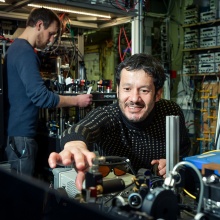Visiting Humboldt Fellow Prof. Óscar Herrera-Sancho has been working with Professor Tilman Pfau, Head of the University of Stuttgart's 5th Institute of Physics since November 2022. His initial study visit phase is due to end in April 2023 and will be followed by two more during the following two years, each of which will also last from November to April – as we know, not the best time of year to visit Germany. But this Costa Rican actually likes the cold, and low temperatures also play a major role in his research.
Working in a supercooled gas cloud
Some of the main research focuses at the University of Stuttgart’s 5th Institute of Physics which also fascinate Humboldt Fellow Óscar Herrera-Sancho, involves experiments in the field of atomic, molecular, and optical physics as well as the study of Rydberg atoms. Researchers there use supercooled gas clouds to create Rydberg atoms. Up to now, Prof. Herrera-Sancho has been experimenting with rubidium, which only has a single electron in its outer shell, which forms a so-called Rydberg atom when moved far from the nucleus. One feature of these atoms is that at least one electron exists in a highly excited state over a thousand times farther away from the atomic nucleus than in its basic state. Which is why Rydberg atoms are also referred to as giant atoms, whose properties are very different from those that exist in the basic state. The researchers are specifically investigating interactions between Rydberg atoms and ions in their laboratory, a process during which the electric field of the positively charged ion influences the Rydberg atom, and have, for example, demonstrated a new molecular bond between ions and Rydberg atoms.
The atoms are observed via an ion microscope, which is comparable to an electron microscope except that it measures the positive ions rather than the negatively charged electrons, as is the case with the electron microscope. The microscope comprises three lenses and achieves a relatively high spatial resolution of 200 nanometres.
Ion microscope reveals vibrations in single atoms
The entire system is contained in a vacuum in which a furnace is used to evaporate rubidium at about 100°C after which the hot rubidium atoms pass through a tube at about 1000 km/h, where magnetic fields and laser beams slow them down to the point that they hardly move at all. This cools the atoms to a temperature of -273°C, just above absolute zero, a temperature at which the Brownian zitterbewegung (German for “jittery motion”) is suppressed, which makes it possible to observe the actual motion of the atoms themselves.
"Using an ion microscope gives us a comparatively clear image of the atoms," the Costa Rican physicist explains," which means that we can even observe the vibrations of the molecules.”
New results expected from lithium
The researchers are expecting interesting results from the use of lithium atoms. One of Herrera-Sancho's tasks will be to oversee this changeover. Lithium is about 12 times lighter than rubidium, which makes it easier to penetrate into areas of physics in which quantum mechanical effects become dominant in certain experiments.
Interest sparked by well-known German natural scientists
Prof. Herrera-Sancho did his PhD in Hannover between 2009 and 2012 and later worked as a postdoc in Innsbruck. He met Prof. Tilman Pfau at a conference in New Zealand and was extremely impressed by a lecture he presented, which is how they got to know each other resulting in an initial research stay at the University of Stuttgart in 2020. After successfully applying for a scolarship from the Alexander von Humboldt Foundation, the physicist will be able to continue his research at the 5th Institute of Physics for another 18 months. Spreading his research over three stays in Stuttgart will allow Herrera-Sancho to continue his research in Costa Rica, where, among other things, he is using artificial magnetic fields to investigate the migratory behavior of butterflies as well as looking into the history and material composition of old paintings at the National Theater in the state capital, San José.
Humboldt Fellow Herrera-Sancho's interest in Germany began at an early age and was sparked not least because of the many renowned German natural scientists. He likes how organized everything is here and also the different seasons. He was attracted to the far north and spent the turn of the year in Iceland and talks enthusiastically about the auroras he saw there.






